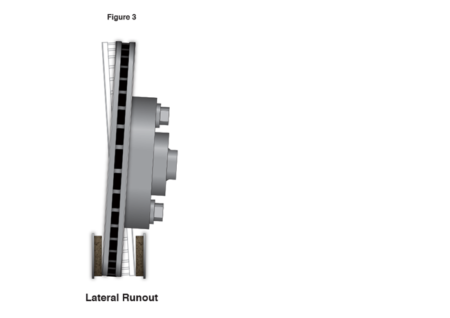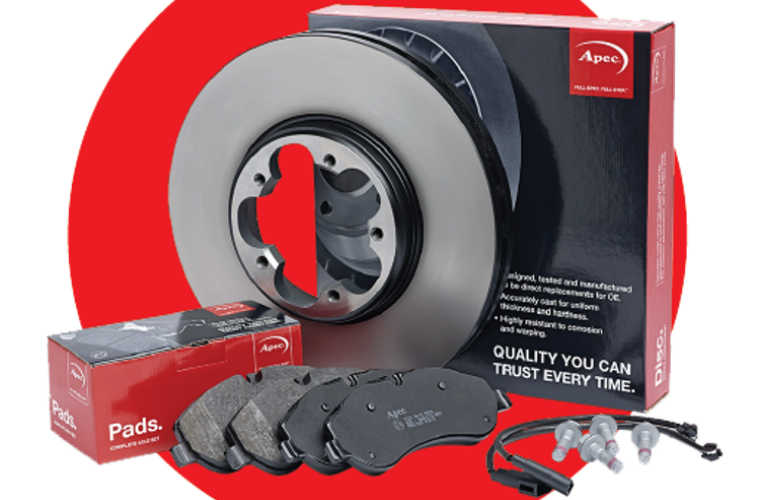Apec Braking is this month sharing it’s knowledge on the issue of brake judder, which it describes as a sensation that can be felt through the steering wheel, the brake pedal and potentially through the seat.
Depending on the severity of the judder, drivers may even feel the car shake.
Brake judder can often be an uncomfortable, frustrating and disconcerting experience which may result in the driver reducing their braking pressure to reduce their discomfort, increasing stopping distances as a result.
Drivers and mechanics often jump to one conclusion; that the brake discs are no good and have ‘warped’.
Brake judder symptoms and causes
If a new set of brake discs is fitted to a vehicle and brake judder is immediately felt, the conclusion maybe that discs have been manufactured incorrectly.
However, all Apec brake discs are tested before leaving the factory to ensure that this scenario does not occur.
Immediate brake judder can only be as a result of a mechanical issue that has not been diagnosed such as a severely worn or damaged hub, steering and suspension components or loose wheel bolts to name a few examples.
If any underlying issues are not resolved, then the issue will remain and potentially lead to catastrophic mechanical failure.
Progressive fault
Most frequently, brake judder is not felt immediately and will develop over time.
The assumption is that the brake discs are poorly manufactured and are unable to withstand the heat from braking and have warped.
However due to modern manufacturing processes and materials used, it is extremely rare for any brake disc to warp.
For warping to happen you will need a combination of extreme conditions – eg glowing hot discs and then driving through standing water, or excessive overheating and insufficient cooling.
The true causes of brake judder are far more complicated than the disc warping.
Disc thickness variation
The brake disc developing disc thickness variation (DTV) over time, is the most common cause of judder.

Disc thickness variation is when the disc has worn unevenly, causing the two friction surfaces of the disc to no longer be parallel with each other.
This is often confused with disc warping.
Warping is defined as distortion, where the disc is a uniform thickness in width.
There is often little diagnosis that is carried out to solve the issue of brake judder, apart from test driving the vehicle.
As soon as judder is experienced, which is blamed on the disc warping, the brake discs are removed and replaced with a new set, curing the issue for the next 2000-5000 miles only for the juddering to return.
Material transfer
The primary cause of DTV is uneven material transfer.
During the bedding in process, and subsequent braking applications, a microscopic layer of brake pad friction material must transfer evenly from the pad to the surface of the brake disc.
This is known as the adherent friction process.
Anything that will affect this process – eg mechanical, or braking style will result in uneven material transfer, which starts the process of DTV.
Due to uneven friction material transferring across the surface of the disc, this will lead to high-spots.
The high spots will heat excessively in comparison to the rest of the disc.
If the temperature at these high-spots exceeds 650 deg. C, cast iron changes structurally, transforming into a harder substance called Cementite.
As the disc is now composed of varying materials of different hardness, the two materials will wear at a different rate.
The important point to note is that this will not immediately induce brake judder but has provided the foundations for a vibration that will eventually lead to irreparable damage to the braking disc, although this may not occur for over 2000-5000 driven miles.
This explains why customers often return with their vehicles complaining of brake judder months after the discs were originally installed.
With DTV the disc surface will not have warped, but if measured with a micrometer at (at least) 8 equal points around the brake disc, there will be a variation of thickness.
A disc thickness variation of >30µm (>0.03mm) will result in the symptom of ‘brake judder’ caused by the brake pads pulsating over the uneven surface.
This in turn causes the pistons to kick back over every high spot causing the pedal to pulsate replicating brake judder symptoms.
To ensure that the new brake discs that you are fitting do not already have DTV all Apec brake discs are tested before leaving the factory and will have a disc thickness variation of <13µm (<0.013mm).
Skimming the discs will temporarily remove the high spots and judder, however the hard spots of cementite will remain under the surface and the high spots and judder will return after several thousand miles.
As detailed above, a major cause of brake judder is uneven material transfer, leading to Disc Thickness Variation (DTV).
The single biggest cause of uneven material transfer is lateral run-out.
Lateral runout

Lateral runout is when the disc is not parallel to the hub surface and therefore deviating from its true axis (see Figure 3).
What causes lateral runout?
- Not following best practice.
- Insufficient cleaning of the hub surface (even minuscule particles of rust or debris caught between the disc face and hub can lead to excessive lateral runout).
- Corrosion build up after the new discs have been fitted. (Using copper grease on the hub surface? not replacing a missing disc location screw).
- A worn or damaged hub, hub flange and/or wheel bearing.
- Worn steering and suspension components.
- Over torqueing of the disc location screw.
- Over torqueing of the wheel bolt.
- Low quality refurbished alloy wheels (uneven paint thickness).
- This list in not exhaustive (further information on lateral runout can be found in our “lateral runout” article).
Other causes of uneven material transfer:
- Not following best practice
- The brake pads rubbing on the disc while not braking due to a sticking pad, slider bolt or caliper.
- The brake pads not contacting the disc evenly when braking due to a sticking pad, slider bolt or caliper.
- Failure to adhere to the correct bedding in process.
- Sitting with the brake applied for long periods of time while stationary. (Pad etching).
- Severe over heating of the discs.
Static spots
If a vehicle is parked up for an extended period, especially in an area of high humidity and salt content, such as close to the coast, then this can cause corrosion to build up between the disc and pad causing them to adhere to each other.
The brakes can be freed off by softly twitching the vehicle by speedily releasing the clutch.
The corrosion leads to the formation of static spots which causes severe judder under braking.
Should the corrosion be so severe it will also cause damage to the brake pads.
Dependent on the level of corrosion on the brake disc there will be judder temporarily while the corrosion is present on the surface of the disc.
Should this judder continue, the resolution to cure the judder would be to replace the brake discs.
Brake disc below the minimum thickness
A brake disc is subjected to compressive and centrifugal force, which creates a force of traction.
Compressive strength of the disc is the capacity of the disc to withstand clamp load from the brake pads.
The compressive strength of a worn disc decreases as it wears.
If it exceeds the material’s resilient limit, deformation begins as soon as the disc cools down leading to cracks appearing or warping.
Therefore it is crucial to replace the brake discs when the braking surface thickness is less than the minimum thickness engraved on the outer disc diameter.
Now that you have a better understanding of the root causes of most cases of brake judder, we can move on and explain the best practices that always need to be adhered to and other preventative steps to eliminate it.
To find out more about Apec, select the ‘more details’ link.







